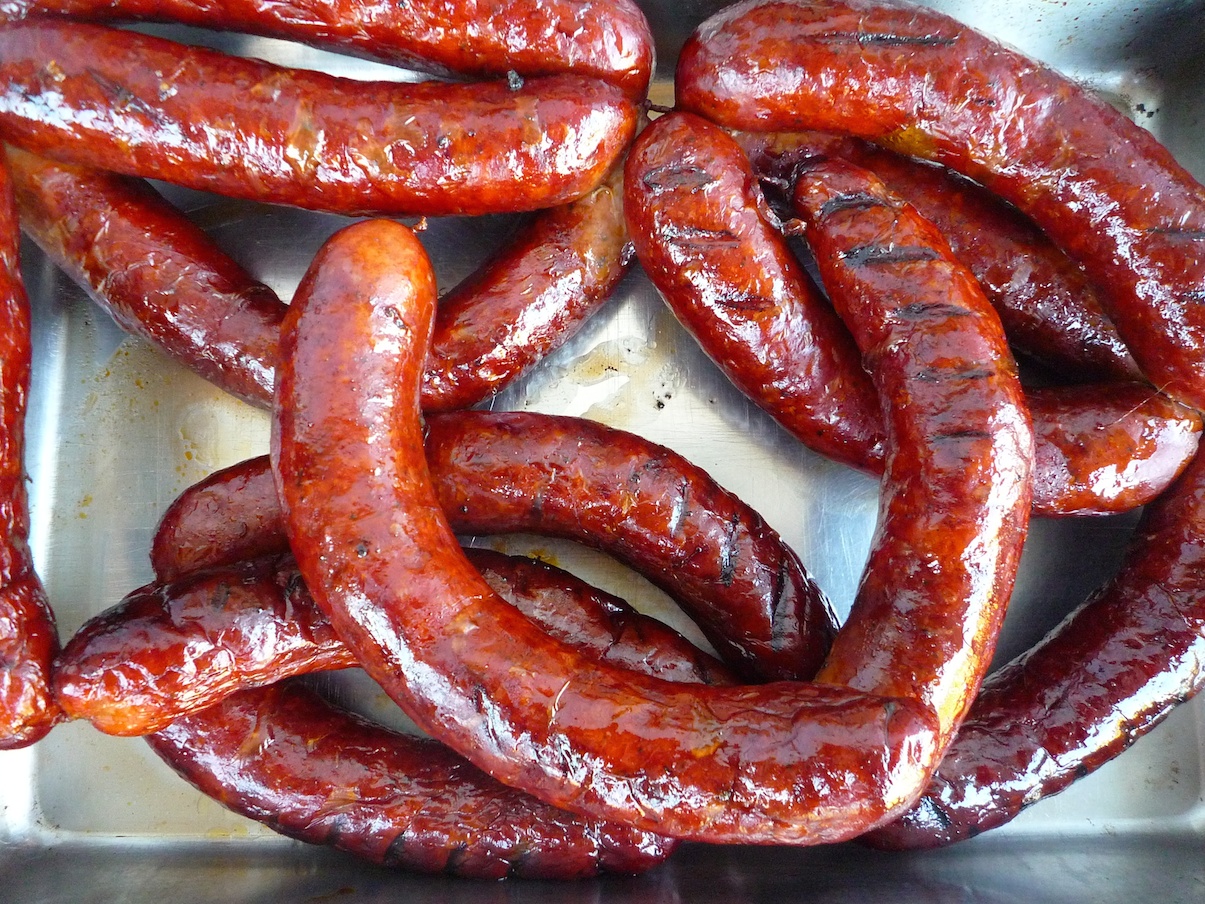You've read some background on Hoppin' John, now here are the recipes:
1. John Thorne's master recipe for Hoppin' John in Serious Pig reflects the passion and erudition that went into his chapter on Rice & Beans.
John Thorne's Hoppin' John
1 cup black-eyed peas or cowpeas, soaked and prepared for cooking
1 small chunk of lean slab bacon, sliced thick OR a cracked ham or beef bone OR a chunk of salt pork, sliced and simmered in enough water for 15 minutes to reduce its saltiness
1 onion, chopped
1 cup raw rice
1 hot red pepper, fresh or dried, seeded and diced OR Tabasco sauce to taste
and all, some, or one of the following, according to your taste
1 clove of garlic, minced
1 bay leaf
minced fresh parsley
a little thyme
salt and pepper
Bring 5 cups of water to a boil. Add the beans, with the bay leaf (if using), and let them simmer for about 45 minutes. (If you are using a cracked pork or beef bone, you should add it now, too, and ignore all the bacon/salt pork instructions, frying up the onion in a bit of melted fat or oil and adding it when you add the rice.) While the beans are cooking, prepare the bacon/salt pork by frying it until the pieces are crisp. Either reserve these until the end of cooking (to lend a touch of crispness) or put them into the beans when the rice is added. Fry the onion in the fat once the pork has been removed until it is translucent but not brown. Either way, reserve the fat.
At the end of 45 minutes, taste the beans for doneness; your tongue should be able to mash them against the roof of the mouth. If they are soft, but not mushy, they are done just right. Eyeball the remaining liquid in the pot--there should be at least 2 1/2 cups. If not, add more water. Pour in the rice and mix in all the other seasonings, the bacon/salt pork bits (unless you're holding them for the end), and all--or as much as you want of--the cooking fat. Stir the mixture well and bring the liquid to a simmer. Let cook for another 20 minutes. Then turn off the heat and let the Hoppin' John rest for 10 minutes. Taste. The beans should be just a little more tender, the rice perfectly cooked. Crumble over the reserved bacon or sprinkle over the crisp salt-pork bits, if any, and serve.
Serves 4 "very well indeed."
2. Matt and Ted Lee's The Lee Bros. Southern Cookbook features another thoughtful and reliable take on Hoppin' John, which makes great use of their tasty Rich Pork Broth (see below).
Lee Bros. Hoppin' John
1 cup dried black-eyed peas or field peas
2 tbsp olive oil
1 smoked hog jowl (or 1/4 pound slab bacon or 4 slices thick-cut bacon)
1 medium yellow onion, coarsely chopped
6 cups Rich Pork Broth (see below)
1/2 tsp freshly ground black pepper
1 tsp crushed red pepper flakes
1 tsp salt
14-oz can crushed Italian tomatoes
1 1/2 cups long-grain rice
Wash the peas in a strainer, place them in a medium bowl, and soak for 4 hours in water to cover.
Heat the olive oil in a 4-quart pot over medium-high heat and brown the hog jowl on both sides, about 5 minutes. (If using bacon, omit the olive oil and simply render the fat in the pot for 5 minutes.) Add the onion and cook until softened, about 5 minutes. Add the broth, black pepper, red pepper, and salt and bring to a boil.
Let the broth boil vigorously for 10 minutes, then add the drained peas. Boil gently over medium-high heat, uncovered, until the peas are tender but still have some bite, about 25 minutes for black-eyed peas, 30 minutes for field peas. Add the tomatoes and rice to the pot, cover, reduce the heat to low, and simmer vigorously for 20 minutes, until most of the broth has been absorbed but the rice and peas are still very moist.
Remove the pot from the heat and allow the Hoppin' John to steam, covered, until all the liquid has been absorbed, about 5 minutes. Remove the hog jowl and pull off any meat.
Fluff the Hoppin' John with a fork. Transfer to a serving dish, sprinkle the shredded hog jowl over top, and serve.
Serves 6 hungry people.
And here's that recipe for their pork broth:
Lee Bros. Rich Pork Broth
shoulder bones from a bone-in pork shoulder or 1 pound pork shank bones and trimmings
1 large onion, chopped
2 large celery stalks, chopped
4 bay leaves
6 cups cold water
salt and freshly ground black pepper to taste
Place the bones, onion, celery, and bay leaves in a medium stockpot and cover with cold water. Bring to a vigorous simmer over medium-high heat, then turn the heat to low and simmer gently for 1 hour.
Strain the broth into a bowl through a fine-mesh strainer. Discard the solids. Measure the amount of broth that's left. Taste the broth. If you don't plan to reduce it further, season it gently with salt and pepper.
Pour the broth into a container with a tight-fitting lid. If you're going to use it within 48 hours, keep it in the refrigerator. Otherwise, place it in the freezer, where it will keep for at least 1 month.
3. Perhaps not surprisingly, the simplest Hoppin' John recipe can be found in Ernest Matthew Mickler's White Trash Cooking.
Cook enough black-eyed peas with hog jowls until they are tender. Cook a cup of rice for every 2 or 3 hungry people. Stir the rice and peas together and serve.
However, Mickler correctly notes that black-eyed peas aren't the only option. In the words of his friend Kaye Kay, "You can make it out of crowder, field or cow peas."
4. Also unsurprisingly, the most intricate Hoppin' John recipe can be found in Sean Brock's Heritage: Recipes and Stories. As prodigiously talented as Brock is, he's got a knack for taking Southern classics and busying them up and even getting finicky with them. This recipe for Lowcountry Hoppin' John being a case in point: it features three distinct stages (including an usual drying-of-the-rice step) and almost 20 ingredients (!). A luscious Red Pea Gravy is an element that forms naturally when you cook up a good batch of Hoppin' John, but Brock insists that it stands out even further, and he uses a blender (!) to achieve this end. In my mind, the genius of this recipe has to do with its attention to ingredients, especially its insistence that Anson Mills Sea Island Red Peas and Carolina Gold Rice--both of them heirloom varieties, both of them of an exceptional quality--be used.
Sean Brock's Hoppin' John (Hoppin' Sean?)
Peas
2 quarts Pork Stock or Chicken Stock
1 cup Anson Mills Sea Island Red Peas, soaked in a pot of water in the refrigerator overnight
1 1/2 cups medium dice onions
1 cup medium dice peeled carrots
1 1/2 cups medium dice celery
2 garlic cloves, thinly sliced
1 fresh bay leaf
10 thyme sprigs
1/2 jalapeño, chopped
Kosher salt
Rice
4 cups water
1 teaspoon kosher salt
1/4 teaspoon cayenne pepper
1 cup Anson Mills Carolina Gold Rice
4 tablespoons unsalted butter, cubed
Red Pea Gravy
Reserved 1 cup cooked red peas
Reserved 2 cups cooking liquid from the peas
1 tablespoon unsalted butter
Cider vinegar
Sliced chives or scallions for garnish
For the peas:
Bring the stock to a simmer in a small pot. Drain the peas and add to the stock, along with all of the remaining ingredients except the salt. Cook the peas, partially covered, over low heat until they are soft, about 1 hour. Season to taste with salt. (The peas can be cooked ahead and refrigerated in their liquid for up to 3 days; reheat, covered, over low heat before proceeding.)
Drain the peas, reserving their cooking liquid, and measure out 1 cup peas and 2 cups liquid for the gravy; return the rest of the peas and liquid to the pot and keep warm.
Meanwhile, for the rice:
About 45 minutes before the peas are cooked, preheat the oven to 300°F.
Bring the water, salt, and cayenne pepper to a boil in a large saucepan over medium-high heat. Reduce the heat to medium, add the rice, stir once, and bring to a simmer. Simmer gently, uncovered, stirring occasionally, until the rice is al dente, about 15 minutes.
Drain the rice in a sieve and rinse under cold water. Spread the rice out on a rimmed baking sheet. Dry the rice in the oven, stirring occasionally, for 10 minutes. Scatter the butter evenly over the rice and continue to dry it, stirring every few minutes, for about 5 minutes longer. All excess moisture should have evaporated and the grains should be dry and separate.
For the gravy:
Put the 1 cup peas, 2 cups cooking liquid, and the butter in a blender and blend on high until smooth, about 3 minutes. Add cider vinegar to taste.
(The gravy can be made up to 3 days ahead and kept in a covered container in the refrigerator; reheat, covered, over the lowest possible heat, stirring occasionally to prevent scorching.)
To complete:
Use a slotted spoon to transfer the peas to a large serving bowl. Add the rice and carefully toss the rice and peas together. Pour the gravy over them, sprinkle with chives or scallions, and serve.
Serves 6 to 8 hungry souls.
[excerpted from Sean Brock's Heritage: Recipes and Stories]
Hoppin' John is a complete meal, so you don't really need to serve it with too much else if you're serving it as a main. A brightly flavoured fresh salad makes a lot of sense. So does a batch of skillet corn bread.







































































































































